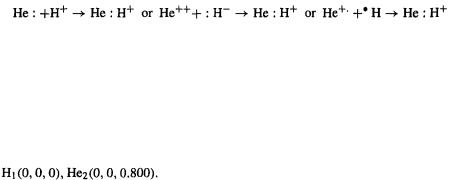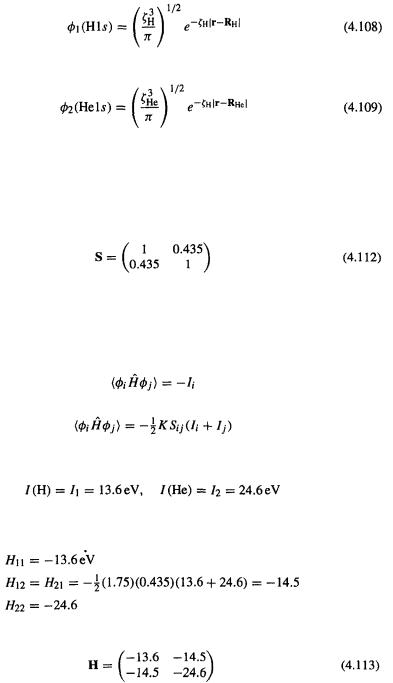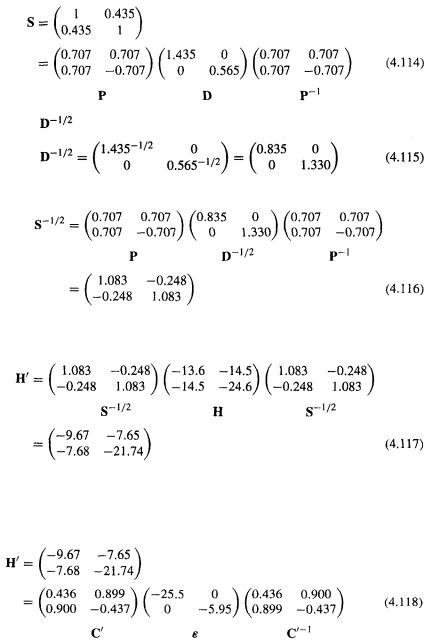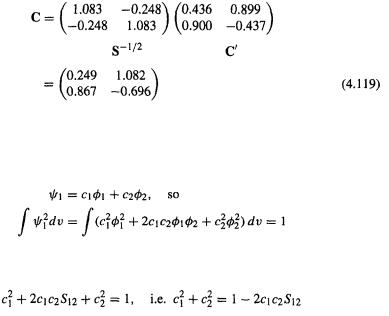
- •COMPUTATIONAL CHEMISTRY
- •CONTENTS
- •PREFACE
- •1.1 WHAT YOU CAN DO WITH COMPUTATIONAL CHEMISTRY
- •1.2 THE TOOLS OF COMPUTATIONAL CHEMISTRY
- •1.3 PUTTING IT ALL TOGETHER
- •1.4 THE PHILOSOPHY OF COMPUTATIONAL CHEMISTRY
- •1.5 SUMMARY OF CHAPTER 1
- •REFERENCES
- •EASIER QUESTIONS
- •HARDER QUESTIONS
- •2.1 PERSPECTIVE
- •2.2 STATIONARY POINTS
- •2.3 THE BORN–OPPENHEIMER APPROXIMATION
- •2.4 GEOMETRY OPTIMIZATION
- •2.6 SYMMETRY
- •2.7 SUMMARY OF CHAPTER 2
- •REFERENCES
- •EASIER QUESTIONS
- •HARDER QUESTIONS
- •3.1 PERSPECTIVE
- •3.2 THE BASIC PRINCIPLES OF MM
- •3.2.1 Developing a forcefield
- •3.2.2 Parameterizing a forcefield
- •3.2.3 A calculation using our forcefield
- •3.3 EXAMPLES OF THE USE OF MM
- •3.3.2 Geometries and energies of polymers
- •3.3.3 Geometries and energies of transition states
- •3.3.4 MM in organic synthesis
- •3.3.5 Molecular dynamics and Monte Carlo simulations
- •3.4 GEOMETRIES CALCULATED BY MM
- •3.5 FREQUENCIES CALCULATED BY MM
- •3.6 STRENGTHS AND WEAKNESSES OF MM
- •3.6.1 Strengths
- •3.6.2 Weaknesses
- •3.7 SUMMARY OF CHAPTER 3
- •REFERENCES
- •EASIER QUESTIONS
- •HARDER QUESTIONS
- •4.1 PERSPECTIVE
- •4.2.1 The origins of quantum theory: blackbody radiation and the photoelectric effect
- •4.2.2 Radioactivity
- •4.2.3 Relativity
- •4.2.4 The nuclear atom
- •4.2.5 The Bohr atom
- •4.2.6 The wave mechanical atom and the Schrödinger equation
- •4.3.1 Introduction
- •4.3.2 Hybridization
- •4.3.3 Matrices and determinants
- •4.3.4 The simple Hückel method – theory
- •4.3.5 The simple Hückel method – applications
- •4.3.6 Strengths and weaknesses of the SHM
- •4.4.1 Theory
- •4.4.2 An illustration of the EHM: the protonated helium molecule
- •4.4.3 The extended Hückel method – applications
- •4.4.4 Strengths and weaknesses of the EHM
- •4.5 SUMMARY OF CHAPTER 4
- •REFERENCES
- •EASIER QUESTIONS
- •5.1 PERSPECTIVE
- •5.2.1 Preliminaries
- •5.2.2 The Hartree SCF method
- •5.2.3 The HF equations
- •5.2.3.1 Slater determinants
- •5.2.3.2 Calculating the atomic or molecular energy
- •5.2.3.3 The variation theorem (variation principle)
- •5.2.3.4 Minimizing the energy; the HF equations
- •5.2.3.5 The meaning of the HF equations
- •5.2.3.6a Deriving the Roothaan–Hall equations
- •5.3 BASIS SETS
- •5.3.1 Introduction
- •5.3.2 Gaussian functions; basis set preliminaries; direct SCF
- •5.3.3 Types of basis sets and their uses
- •5.4 POST-HF CALCULATIONS: ELECTRON CORRELATION
- •5.4.1 Electron correlation
- •5.4.3 The configuration interaction approach to electron correlation
- •5.5.1 Geometries
- •5.5.2 Energies
- •5.5.2.1 Energies: Preliminaries
- •5.5.2.2 Energies: calculating quantities relevant to thermodynamics and to kinetics
- •5.5.2.2a Thermodynamics; “direct” methods, isodesmic reactions
- •5.5.2.2b Thermodynamics; high-accuracy calculations
- •5.5.2.3 Thermodynamics; calculating heats of formation
- •5.5.2.3a Kinetics; calculating reaction rates
- •5.5.2.3b Energies: concluding remarks
- •5.5.3 Frequencies
- •Dipole moments
- •Charges and bond orders
- •Electrostatic potential
- •Atoms-in-molecules
- •5.5.5 Miscellaneous properties – UV and NMR spectra, ionization energies, and electron affinities
- •5.5.6 Visualization
- •5.6 STRENGTHS AND WEAKNESSES OF AB INITIO CALCULATIONS
- •5.7 SUMMARY OF CHAPTER 5
- •REFERENCES
- •EASIER QUESTIONS
- •HARDER QUESTIONS
- •6.1 PERSPECTIVE
- •6.2 THE BASIC PRINCIPLES OF SCF SE METHODS
- •6.2.1 Preliminaries
- •6.2.2 The Pariser-Parr-Pople (PPP) method
- •6.2.3 The complete neglect of differential overlap (CNDO) method
- •6.2.4 The intermediate neglect of differential overlap (INDO) method
- •6.2.5 The neglect of diatomic differential overlap (NDDO) method
- •6.2.5.2 Heats of formation from SE electronic energies
- •6.2.5.3 MNDO
- •6.2.5.7 Inclusion of d orbitals: MNDO/d and PM3t; explicit electron correlation: MNDOC
- •6.3 APPLICATIONS OF SE METHODS
- •6.3.1 Geometries
- •6.3.2 Energies
- •6.3.2.1 Energies: preliminaries
- •6.3.2.2 Energies: calculating quantities relevant to thermodynamics and kinetics
- •6.3.3 Frequencies
- •6.3.4 Properties arising from electron distribution: dipole moments, charges, bond orders
- •6.3.5 Miscellaneous properties – UV spectra, ionization energies, and electron affinities
- •6.3.6 Visualization
- •6.3.7 Some general remarks
- •6.4 STRENGTHS AND WEAKNESSES OF SE METHODS
- •6.5 SUMMARY OF CHAPTER 6
- •REFERENCES
- •EASIER QUESTIONS
- •HARDER QUESTIONS
- •7.1 PERSPECTIVE
- •7.2 THE BASIC PRINCIPLES OF DENSITY FUNCTIONAL THEORY
- •7.2.1 Preliminaries
- •7.2.2 Forerunners to current DFT methods
- •7.2.3.1 Functionals: The Hohenberg–Kohn theorems
- •7.2.3.2 The Kohn–Sham energy and the KS equations
- •7.2.3.3 Solving the KS equations
- •7.2.3.4a The local density approximation (LDA)
- •7.2.3.4b The local spin density approximation (LSDA)
- •7.2.3.4c Gradient-corrected functionals and hybrid functionals
- •7.3 APPLICATIONS OF DENSITY FUNCTIONAL THEORY
- •7.3.1 Geometries
- •7.3.2 Energies
- •7.3.2.1 Energies: preliminaries
- •7.3.2.2 Energies: calculating quantities relevant to thermodynamics and kinetics
- •7.3.2.2a Thermodynamics
- •7.3.2.2b Kinetics
- •7.3.3 Frequencies
- •7.3.6 Visualization
- •7.4 STRENGTHS AND WEAKNESSES OF DFT
- •7.5 SUMMARY OF CHAPTER 7
- •REFERENCES
- •EASIER QUESTIONS
- •HARDER QUESTIONS
- •8.1 FROM THE LITERATURE
- •8.1.1.1 Oxirene
- •8.1.1.2 Nitrogen pentafluoride
- •8.1.1.3 Pyramidane
- •8.1.1.4 Beyond dinitrogen
- •8.1.2 Mechanisms
- •8.1.2.1 The Diels–Alder reaction
- •8.1.2.2 Abstraction of H from amino acids by the OH radical
- •8.1.3 Concepts
- •8.1.3.1 Resonance vs. inductive effects
- •8.1.3.2 Homoaromaticity
- •8.2 TO THE LITERATURE
- •8.2.1 Books
- •8.2.2 The Worldwide Web
- •8.3 SOFTWARE AND HARDWARE
- •8.3.1 Software
- •8.3.2 Hardware
- •8.3.3 Postscript
- •REFERENCES
- •INDEX

146 Computational Chemistry
geometry can in principle be used to find minima and transition states (see chapter 2). This brings us to the matter of how the EHM calculates the energy of a molecule. The energy of a molecule, that is, the energy of a particular nuclear configuration on the potential energy surface, is the sum of the electronic energies and the internuclear repulsions
In comparing the energies of isomers, or of two geometries of the same molecule, one should, strictly, compare  The electronic energy is the sum of kinetic energy and potential energy (electron–electron repulsion and electron–nucleus attraction) terms. The internuclear repulsion, due to all pairs of interacting nuclei and trivial to calculate, is usually represented by V, a symbol for potential energy. The EHM ignores
The electronic energy is the sum of kinetic energy and potential energy (electron–electron repulsion and electron–nucleus attraction) terms. The internuclear repulsion, due to all pairs of interacting nuclei and trivial to calculate, is usually represented by V, a symbol for potential energy. The EHM ignores  Furthermore, the method calculates electronic energy simply as the sum of one-electron energies (section 4.3.5), ignoring electron-electron repulsion. Hoffmann’s tentative justification [53a] for ignoring internuclear repulsion and using a simple sum of one-electron energies was that when the relative energies of isomers are calculated, by subtracting two values of
Furthermore, the method calculates electronic energy simply as the sum of one-electron energies (section 4.3.5), ignoring electron-electron repulsion. Hoffmann’s tentative justification [53a] for ignoring internuclear repulsion and using a simple sum of one-electron energies was that when the relative energies of isomers are calculated, by subtracting two values of  the electron repulsion and nuclear repulsion terms approximately cancel, i.e. that changes in energy that accompany changes in geometry are due mainly to alterations of the MO energy levels. Actually, it seems that the (quite limited) success of the EHM in predicting molecular geometry is due to the fact that
the electron repulsion and nuclear repulsion terms approximately cancel, i.e. that changes in energy that accompany changes in geometry are due mainly to alterations of the MO energy levels. Actually, it seems that the (quite limited) success of the EHM in predicting molecular geometry is due to the fact that
 is approximately proportional to the sum of the occupied MO energies; thus although the EHM energy difference is not equal to the difference in total energies, it is (or tends to be) approximately proportional to this difference [56]. In any case, the real strength of the EHM lies in the ability of this fast and widely applicable method to assist chemical intuition, if provided with a reasonable molecular geometry.
is approximately proportional to the sum of the occupied MO energies; thus although the EHM energy difference is not equal to the difference in total energies, it is (or tends to be) approximately proportional to this difference [56]. In any case, the real strength of the EHM lies in the ability of this fast and widely applicable method to assist chemical intuition, if provided with a reasonable molecular geometry.
4.4.2An illustration of the EHM: the protonated helium molecule
Protonation of a helium atom gives  the helium hydride cation, the simplest heteronuclear molecule [57]. Conceptually, of course, this can also be formed by the union of a helium dication and a hydride ion, or a helium cation and a hydrogen atom:
the helium hydride cation, the simplest heteronuclear molecule [57]. Conceptually, of course, this can also be formed by the union of a helium dication and a hydride ion, or a helium cation and a hydrogen atom:
Its lower symmetry makes this molecule better than for illustrating molecular quantum mechanical calculations (most molecules have little or no symmetry). Following the prescription in points (1)–(7), we calculate the following results.
for illustrating molecular quantum mechanical calculations (most molecules have little or no symmetry). Following the prescription in points (1)–(7), we calculate the following results.
(1) Input structure
We choose a plausible bond length: 0.800 Å (the H–H bond length is 0.742 Å and the H–X bond length is ca. 1.0 Å, where X is a “first-row” element (in quantum chemistry, first-row means Li to F, not H and He). The Cartesian coordinates could be written
(2) Overlap integrals and overlap matrix
The minimal valence basis set here consists of the hydrogen 1s orbital  and the helium 1s orbital
and the helium 1s orbital  The needed integrals are
The needed integrals are  and
and  where
where

Introduction to Quantum Mechanics 147
 The Slater functions for
The Slater functions for  and
and  are [58]
are [58]
and
Reasonable values [57] are  and
and  if
if  is in atomic units, a.u. (see section 5.2.2); 1
is in atomic units, a.u. (see section 5.2.2); 1  Å. The overlap integrals are
Å. The overlap integrals are  (as must be the case if
(as must be the case if  and
and  are normalized and
are normalized and  (for all well-behaved functions
(for all well-behaved functions 
The overlap matrix is thus
(3) Fock matrix
We need the matrix elements  and
and  where the integrals
where the integrals 
 are not actually calculated from first principles but rather are estimated with
are not actually calculated from first principles but rather are estimated with
the aid of overlap integrals and orbital ionization energies:
Using simply the ionization energies (cf. [55]):
Hoffmann used in his initial calculations [53a]  So
So
And the Fock matrix is

148Computational Chemistry
(4)Orthogonalizing matrix
As explained above, we (a) diagonalize S, (b) calculate  then (c) calculate the orthogonalizing matrix
then (c) calculate the orthogonalizing matrix 
(a) Diagonalize S
(b)Calculate
(c)Calculate the orthogonalizing matrix 
(5) Transformation of the original Fock matrix H to 
Using Eq. (102):
(6) Diagonalization of 
From Eq. (4.104)  diagonalization of
diagonalization of  gives an eigenvector matrix
gives an eigenvector matrix  and the eigenvalue matrix
and the eigenvalue matrix  the columns of
the columns of  are the coefficients of the transformed,
are the coefficients of the transformed,
orthonormal basis functions:

Introduction to Quantum Mechanics 149
We now have the energy levels (–25.5 and –5.95 eV), but the eigenvectors of  must be transformed to give us the coefficients of the original, nonorthogonal basis functions.
must be transformed to give us the coefficients of the original, nonorthogonal basis functions.
(7) Transformation of  to C
to C
Using Eq. (4.102), 
Note that unlike the case in the SHM, the sum of the squares of the c’s for an MO does not equal 1, since overlap integrals  for basis functions on different atoms are not set equal to 0; in other words, the basis functions are not assumed to be orthogonal, and the overlap matrix is not a unit matrix. Thus for
for basis functions on different atoms are not set equal to 0; in other words, the basis functions are not assumed to be orthogonal, and the overlap matrix is not a unit matrix. Thus for 
since the probability of finding an electron in  somewhere in space is 1. The basis functions
somewhere in space is 1. The basis functions  are normalized, so
are normalized, so
4.4.3 The extended Hückel method – applications
The EHM was initially applied to the geometries (including conformations) and relative energies of hydrocarbons [53a], but the calculation of these two basic chemical parameters is now much better handled by SE methods like AM1 and PM3 (chapter 6) and by ab initio (chapter 5) methods. The main use of the EHM nowadays is to study large, extended systems [59] like polymers, solids and surfaces. Indeed, of four papers by Hoffmann and coworkers in the J. Am. Chem. Soc. in 1995, using the EHM, three applied it to such polymeric systems [60]. The ability of the method to illuminate problems in solid-state science makes it useful to physicists. Even when not applied to polymeric systems, the EHM is frequently used to study large, heavy-metal-containing molecules [61] that might not be very amenable to ab initio or to other SE approaches.
4.4.4 Strengths and weaknesses of the EHM
Strengths
One big advantage of the EHM over ab initio methods (chapter 5), more elaborate SE methods (chapter 6), and DFT methods (chapter 7), is that the EHM can be applied to
150 Computational Chemistry
very large systems, and can treat almost any element since the only element-specific parameter needed is an ionization energy, which is usually available. In contrast, more elaborate SE methods have not been parameterized for most elements (although recent parameterizations of PM3 and MNDO for transition metals make these much more generally useful than hitherto – chapter 6, section 6.2.6.7). For ab initio and DFT methods, basis sets may not be available for elements of interest, and besides, ab initio and even DFT methods are hundreds of times slower than the EHM and thus limited to much smaller systems. The applicability of the EHM to large systems and a wide variety of elements is one reason why it has been extensively applied to polymeric and solid-state structures. The EHM is faster than more elaborate SE methods because calculation of the Fock matrix elements is so simple and because this matrix needs to be diagonalized only once to yield the eigenvalues and eigenvectors; in contrast, SE methods like AM1 and PM3 (chapter 6), as well as ab initio calculations, require repeated matrix diagonalization because the Fock matrix must be iteratively refined in the SCF procedure (section 5.2.3.6).
The spartan reliance of the EHM on empirical parameters helps to make it relatively easy (in the right hands) to interpret its results, which depend, in the last analysis, only on geometry (which affects overlap integrals) and ionization energies. With a strong dose of chemical intuition this has enabled the method to yield powerful insights, such as counterintuitive orbital mixing [62], and the very powerful Woodward–Hoffmann rules [38].
The applicability to large systems, including polymers and solids, containing almost any kind of atom, and the relative transparency of the physical basis of the results, are the main advantages of the EHM.
Surprisingly for such a conceptually simple method, the EHM has a theoreticallybased advantage over otherwise more elaborate SE methods like AM1 and PM3, in that it treats orbital overlap properly: those other methods use the “neglect of differential overlap” or NDO approximation (section 6.2), meaning that they take  as in the SHM. This can lead to superior results from the EHM [63].
as in the SHM. This can lead to superior results from the EHM [63].
The EHM is a very valuable teaching tool because it follows straightforwardly from the SHM yet uses overlap integrals and matrix orthogonalization in the same fashion as the mathematically more elaborate ab initio method.
Finally, the EHM, albeit more elaborately parameterized than in its original incarnation, has recently been shown to offer some promise as a serious competitor to the very useful and popular SE AM1 method (section 6.2.6.4) for calculating molecular geometries [64].
Weaknesses
The weaknesses of the standard EHM probably arise at least in part from the fact that it does not (contrast the ab initio method, chapter 5) take into account electron spin or electron–electron repulsion, ignores the fact that molecular geometry is partly determined by internuclear repulsion, and makes no attempt to overcome these defects by parameterization (unlike the recent variation which, with the aid of careful parameterization, evidently gives good geometries [64]).
The standard EHM gives, by and large, poor geometries and energies. Although it predicts a C–H bond length of ca. 1.0 Å, it yields C/C bond lengths of 1.92, 1.47 and
